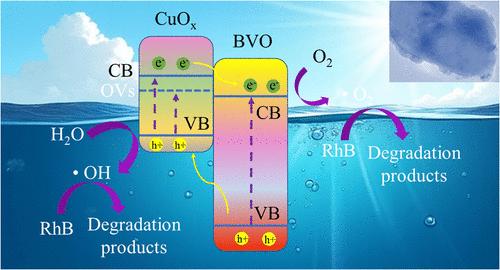Oxygen Vacancy-Rich CuOx/BiVO4 Heterojunction Engineering with Optimized Charge Separation for High-Efficiency Solar-Driven Photocatalysis
IF 3.2
3区 化学
Q2 CHEMISTRY, PHYSICAL
引用次数: 0
Abstract
Oxygen vacancies, as critical lattice defects, demonstrate remarkable advantages in photocatalysis by optimizing electron transport and electrochemical properties, promoting charge separation, and enhancing surface reactivity to improve the photocatalytic performance. Furthermore, the construction of band-aligned heterostructures serves as a vital strategy for optimizing carrier dynamics and boosting light absorption. Herein, a facile H2O2-mediated synthesis strategy was employed to fabricate oxygen vacancy-rich CuOx/BiVO4 (CuOx/BVO) heterojunction photocatalysts. CuOx nanoparticles with abundant oxygen vacancies were successfully loaded onto BVO to form a defective type-II heterojunction. Characterization results revealed that the CuOx/BVO composite exhibited enhanced visible-light absorption, improved charge separation efficiency, and accelerated surface reaction kinetics. Under simulated sunlight, photogenerated holes and electrons migrated to the CuOx and BVO interfaces, participating in oxidation and reduction reactions. The optimized CuOx-3/BVO composite achieved a 4.7-fold higher photocatalytic degradation efficiency for Rhodamine B compared to that of pristine BVO, while maintaining excellent stability over six cycles. This work provides valuable insights for designing defect-engineered heterojunctions in advanced photocatalytic applications.

富氧空位CuOx/BiVO4异质结工程与优化电荷分离用于高效太阳能驱动光催化
氧空位作为关键的晶格缺陷,通过优化电子传递和电化学性能、促进电荷分离、增强表面反应活性来提高光催化性能,在光催化中表现出显著的优势。此外,带向异质结构的构建是优化载流子动力学和提高光吸收的重要策略。本文采用h2o2介导的简单合成策略制备了富氧空位的CuOx/BiVO4 (CuOx/BVO)异质结光催化剂。具有丰富氧空位的CuOx纳米颗粒成功加载到BVO上,形成缺陷型ii异质结。表征结果表明,CuOx/BVO复合材料增强了可见光吸收,提高了电荷分离效率,加速了表面反应动力学。在模拟阳光下,光生空穴和电子迁移到CuOx和BVO界面,参与氧化和还原反应。优化后的CuOx-3/BVO复合材料对罗丹明B的光催化降解效率是原始BVO的4.7倍,同时在6次循环中保持良好的稳定性。这项工作为在先进的光催化应用中设计缺陷工程异质结提供了有价值的见解。
本文章由计算机程序翻译,如有差异,请以英文原文为准。
求助全文
约1分钟内获得全文
求助全文
来源期刊

The Journal of Physical Chemistry C
化学-材料科学:综合
CiteScore
6.50
自引率
8.10%
发文量
2047
审稿时长
1.8 months
期刊介绍:
The Journal of Physical Chemistry A/B/C is devoted to reporting new and original experimental and theoretical basic research of interest to physical chemists, biophysical chemists, and chemical physicists.
 求助内容:
求助内容: 应助结果提醒方式:
应助结果提醒方式:


